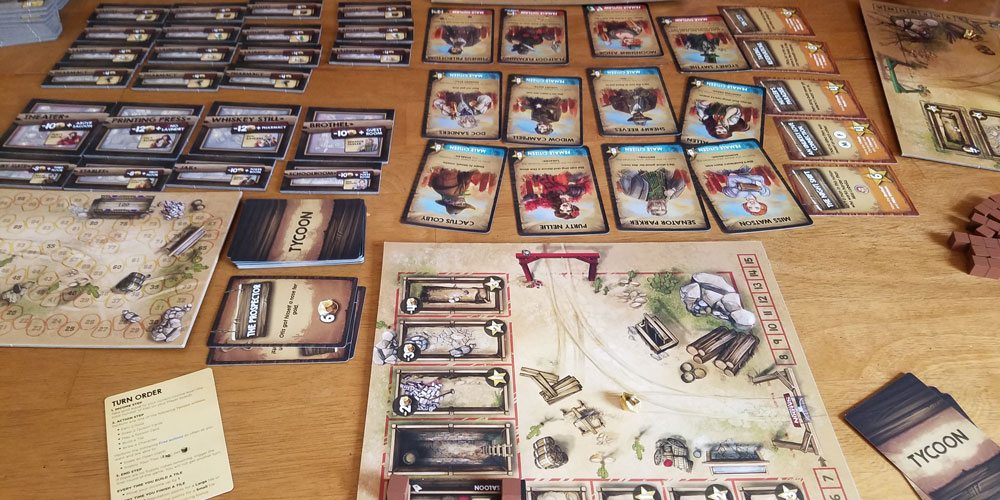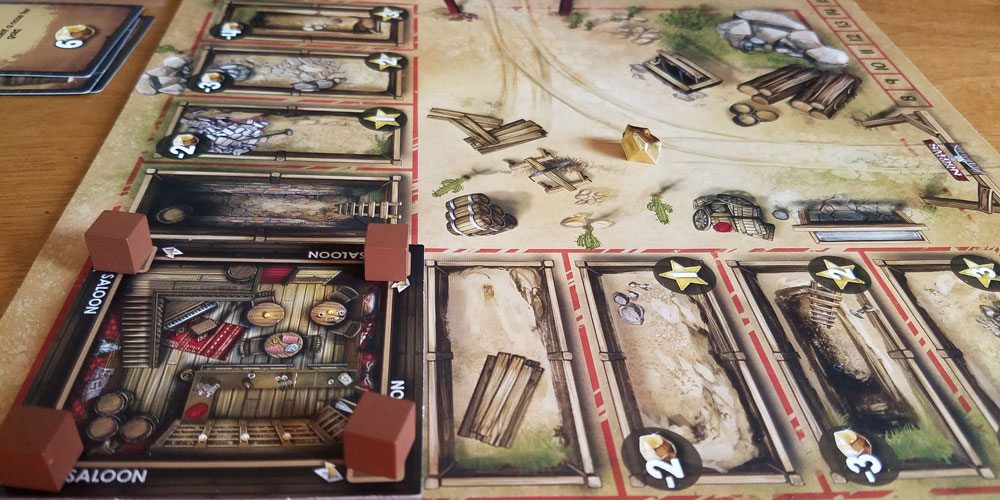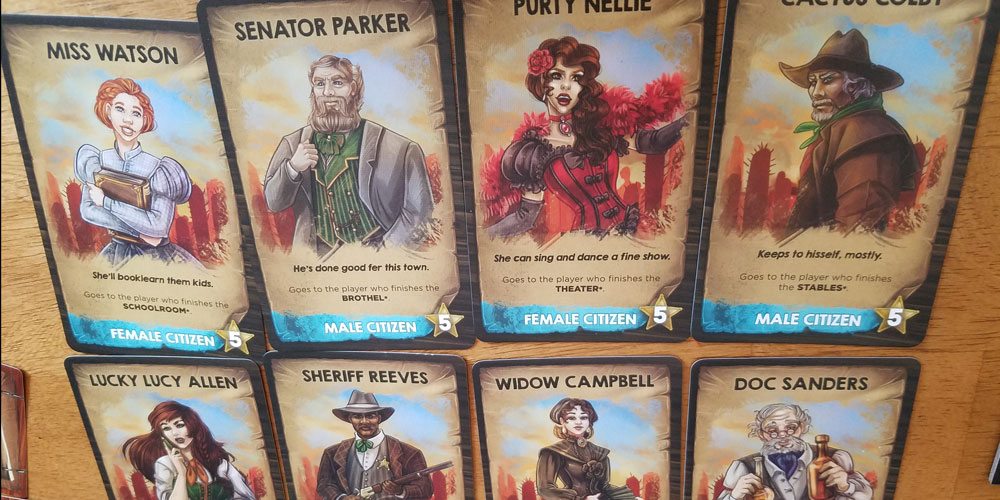
Saloon Tycoon is a tile building game from Nashville studio Van Ryder Games. They were nice enough to give me a copy at Gen Con to look at, and myself and a couple other GeekDads played it in Indianapolis and were quite impressed. I also played a game with my family when I got home, and enjoyed it as much the second time around. The game retails for $50 and is available from Amazon or directly from Van Ryder Games.
Components
* 12 character cards (8 citizens, 4 outlaws)
* 20 large tiles
* 20 small tiles
* 10 large roof tiles
* 10 small roof tiles
* 4 player boards
* 4 player aid cards
* 37 Tycoon cards
* 24 Open Claim cards
* 32 Secret Claim cards
* 100 supply cubes
* 40 small gold nuggets
* 10 large gold nuggets
* 8 cowboy meeples
* Score track board
* Rules
Setup

Each player takes a player board, the saloon tile, and both meeples of the color they choose. The saloon tile is placed in the starting corner place on the board. One of the meeples is placed on the reputation track on the board while the other is placed on the score track board. Shuffle the Tycoon cards and deal 3 to each player. Separately shuffle the Open Claim and Secret Claim cards. Each player is dealt 4 Secret Claim cards, and selects two. The other two and the rest of the Secret Claim cards are returned to the box. Deal Open Claim cards face up on the table equal to the number of players plus 2. There’s a handy table in the rules in case that math is too hard. A set number of supply cubes are set out, equal to 20 per player, with remaining cubes placed to the side since they will be needed at the end of the game. The rest of the components are placed in the table in some sort of semi-organized, or possibly obsessively organized, manner, depending on the players.
The player boards are double-sided but only because the artist really wanted to draw stuff—play on either side of the board is identical. The rules encourage players to lay the mats out so that the boards are oriented so that the saloon tiles face one other, created a central town square effect. This also doesn’t impact game play, but I can assure you that this game will never get played in my presence without that occurring.
Overview
On each turn, players start by collecting gold equal to their current place on their reputation track, which equals the number of building tiles on their board. Thus, they will always draw at least one gold, as it’s impossible to lose buildings in the game.
Then, they get a single action. They can either earn 2 more gold, which is one of those actions you’ll do once or twice in the early rounds and then promptly forget that it’s even a choice once the gold starts flowing in. Or, you can draw 2 Tycoon cards, play a card from your hand, build a tile, or bribe a character.
The Tycoon cards represent actions you can perform in the game. They are all good things, at least for the person playing them, and allow them to do things like get more gold or acquire additional actions. All cards are played and immediately discarded. There’s no minimum or maximum limit to the cards in your hand.
Building tiles is the heart of the game. The tiles represent various aspects of an Old West saloon, including things like laundry, kitchens, guest rooms, or billiard rooms. Some of the tiles are large and others half that size. The small tiles can be stacked on other small tiles, or if two are side-by-side, they can serve as a level for a large tile. However, a small tile cannot be placed by itself on a large tile.

The player board has a series of spaces on which to build. The two spaces next to the starting place are free but every space outward from there has both a cost, in gold, and a reward, in victory points. Players have to be able to pay for both the land and the tile simultaneously in order to build on any but the free spaces.
Each saloon can be a maximum of three stories tall. Once the third level is complete, the player receives, for free, a roof tile. Large roofs are worth four points at the end of the game, while small tiles are worth two. You’ll definitely want to make sure you complete at least one three-story building when you play, just because they look pretty neat with the roof on.
I’ll talk about the final action—bribe a character—in a moment.
At any time during their turn, players are allowed to perform free actions. These include staking an open claim or supplying your tiles. The first option involves selecting one of the Open Claim cards that were dealt to the table during setup. They all have prerequisites before they can be claimed and players earn them automatically as soon as the prerequisite is met. They are all worth victory points at the end of the game.
Supplying your tiles involves buying Supply cubes, the small brown wooden cubes. Each cube costs 2 gold and can be placed on any available space on a building tile. Large tiles have four spaces, and small tiles have three. Players cannot bank cubes, so you can only buy what you immediately place.
Placing the maximum number of cubes on the tile completes the tile. At this point, a new tile may be placed on top of the now-completed one, unless it’s the third level, in case you get a roof, as noted above. Completed tiles also score immediately, which large tiles giving the player 7 points and small tiles 5. If you’re part of a group that has long since stopped even bothering to try to keep score during a game of Ticket to Ride, you’ll be happy to know that you can do the same here, as everything that scores will be visible at the end of the game. So if you’d prefer to be surprised at the end as to who wins, you can ignore scoring during the game.
Tiles also grant the player an immediate bonus upon completion. The bonus range from a free action to more gold to additional tiles. The bonus has to be used immediately, and if it cannot be used (for instance, if the bonus is for additional supply tokens but the player doesn’t have anywhere to put them), it is lost.
Several of the tiles are special tiles, including a luxury suite and a jail. These are unique in the game, and all of them grant additional victory points. They all have prerequisites, so players have to have built (or in some cases, not built) another specific tile before they can build a special tile. They also attract a character to your saloon.
Before I talk about the characters, I do need to pause here and mention that the game contains a few minor adult themes. The special rooms include a brothel and a whiskey room. One of the regular rooms is a poker room. There’s nothing even vaguely suggestive on the tiles themselves. In fact, the game’s graphic designer, Evan Derrick, told me that when he plays with his young daughter, she always wants to build the brothel because it’s the room with the pretty dress. Obviously, parents will need to decide for themselves if these tiles present a problem for them. They could be removed, along with the Claim cards that relate to them, without dramatically impacting game play other than having fewer available tiles.

OK: back to the characters. The game includes 4 outlaws (it is the Wild West, after all) and 8 citizens. The Outlaws are all immediately attracted to a saloon as soon as a particular condition is met and all of them have a negative impact on the player involved. Flatfoot Flemming, for example, is given to the first player who has ten gold on their turn, and she causes that player to earn one less gold each turn. Outlaws will not leave a saloon unless a player bribes them or a card is played that forces them to move. (A few of the outlaws have art and attributes that might also make some parents uncomfortable.)
The citizens all arrive at the saloon that builds their associated building tile. Sheriff Reeves, for example, comes to the player who builds the jail. As with Outlaws, Citizens won’t move unless they are bribed or moved with a card. All Citizens grant victory points to the player who controls them at the end of the game (and it’s important to note that overachievers who manage to actually keep track of the score during the game do not count citizen points until the end.)
The final action option for a player on their turn is to bribe a character. With this action, the player pays 6 gold and moves any Citizen or Outlaw from one player’s saloon to another. The current player does not need to involve their own saloon in this transaction.
Play continues in clockwise order from the starting player (the rules state that this is the person who most recently watched a Western on TV or at the movies) until all of the supply cubes are exhausted. This triggers the end phase. Every other player, except the one who triggered the phase, plays one final turn.
First, no player may move a character for any reason during the end phase. As quite a few of the Secret Claims involve having a particular set of characters, this rule is likely to cause quite a bit of impolite muttering.
Second, the additional supply cubes are put back into play and are available for players to use as a free action on their turn. There can therefore be a flurry of attempts to complete buildings. This final turn is where the one action per turn effect is felt the most, as players who failed to plan for it may find themselves with no meaningful final action. However, careful players will see the cubes running out and make sure to either hold off on completing a building that grants a free action, or else hold a free action card, to allow them to do more than one thing in the final turn.
Once all of the players have gone, final scoring occurs. Victory points from characters are counted, and any completed Secret Claims are revealed and scored. Whomever scores the most points, obviously, wins.
Component Quality

This game is absolutely gorgeous. Of all of the hundreds of games being pushed at GenCon, this was the one that jumped out at me right away. The tiles are nice thick cardboard and look really cool when stacked three or four high with the supply cubes between them. The art on the boards is fantastic. But the coolest part? The gold. The nuggets are that now-standard weird shape that game designers are all using these days for nuggets and crystals, but while they’re plastic, they’re painted with bright, super shiny gold. I don’t know how long they’ll stay super shiny, but while they do I’m going to enjoy looking at this game every time we bring it out.
The rulebook is very well written. It’s nice and short—only 8 pages—and contains enough pictures of what’s going on to keep everything clear. I felt that reading through it alone, without even pulling out the components, was enough to get a feel for the game, which is frustratingly rare these days. It’s also one of the few rulebooks I’ve read that contains a lot of humor.
Verdict
We all had a great time playing this game. There’s quite a bit of strategy and very little luck. While there ends up being a fair amount to track, particularly when you have multiple Outlaws on the board, it’s not a horrible level. And everything important is printed on the cards and boards, so there’s no need to constantly refer back to the rules (even though you might actually want to refer back to the rules for the jokes.) Setup is quick, taking only a few minutes. Both games I’ve played lasted about an hour but I think that time will go down as we learn the rules. I suspect it’s one that is going to get a lot of plays at home. This is a game I’ll be driving people crazy by constantly recommending.
And did I mention how beautiful it is? I sometimes wish I had someplace at home where I could set up games and just have them out to look at, and if I did, there’s no question this would be one of them.

